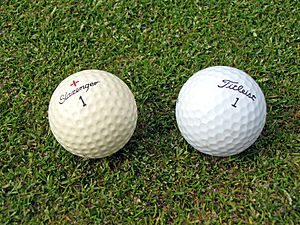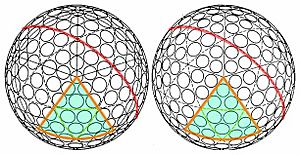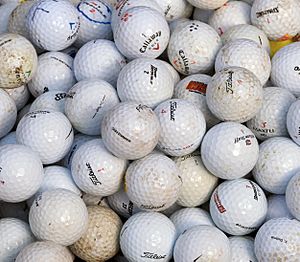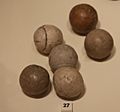Golf ball facts for kids
A golf ball is a special ball used when playing the game of golf. It's designed to fly far and accurately when hit by a golf club.
To make sure the game is fair, golf balls must follow strict rules. A golf ball cannot weigh more than 1.620 ounces (45.93 grams). It also can't be smaller than 1.680 inches (42.67 mm) across. These rules help keep the game balanced for all players. Organizations like The R&A and the United States Golf Association (USGA) test and approve golf balls. If a ball doesn't follow these rules, it can't be used in official competitions.
Contents
Rules for Golf Balls
The main rules for golf balls come from the R&A and the USGA. These groups work together to set the standards. They say a golf ball must be at least 1.680 inches (42.67 mm) wide. It also cannot weigh more than 1.620 ounces (45.93 grams).
Golf balls must also be round and have dimples arranged in a balanced way. These rules help make sure that the ball's flight is fair and predictable. The rules also cover things like how fast a ball can go when hit. They also limit how far it can travel from special test equipment.
These rules help keep golf traditional while still allowing new technology. Before 1990, some tournaments allowed smaller balls. These were called "British" balls. They were a bit smaller than the "American" balls approved by the USGA. The smaller size could help the ball fly farther, especially in windy conditions. But now, all golf balls must meet the same size rules.
How Dimples Help Golf Balls Fly
When a golf ball is hit, it happens very quickly, in less than a millisecond. This hit gives the ball its speed, how high it launches, and how much it spins. All these things affect how the ball flies and where it lands.
As a golf ball moves through the air, two main forces act on it: lift and drag. Dimples on the ball's surface are key to making it fly farther than a smooth ball.
Why Dimples Reduce Drag
The dimples on a golf ball make the air flow around it in a special way. This creates less air resistance, or "drag." Imagine a smooth ball pushing a lot of air in front of it. A dimpled ball creates a smaller area of low pressure behind it. This means less drag, so the ball can travel further.
How Backspin Creates Lift
When you hit a golf ball, it usually spins backward. This is called "backspin." Backspin creates an upward force called the Magnus effect. It works a bit like an airplane wing. The dimples help the air flow around the ball in a way that increases this lift.
Because of backspin, the ball flies higher and stays in the air longer. This helps it travel a greater distance.
How Sidespin Affects Flight
Sometimes, a golf ball spins sideways. This happens if the clubface isn't perfectly straight when it hits the ball. Sidespin makes the ball curve left or right. The dimples allow sidespin to happen, but some dimple designs try to reduce this curving. This helps the ball fly straighter.
To make sure your golf ball flies its best, it's important to keep it clean. Dirt in the dimples can change how the air flows. Golfers often wash their balls with a wet towel or a special ball washer.
Designing a Golf Ball
Dimples became a part of golf balls thanks to an English engineer named William Taylor. In 1905, he patented a dimple design. He noticed that old, used golf balls with bumps and marks often flew farther than new, smooth ones. So, he experimented to find the best surface pattern. He created a design with evenly spaced dimples all over the ball.
Other patterns like "mesh" or "bramble" were used too. But the dimple design became the most popular because it made the ball fly better.
Most modern golf balls have between 300 and 500 dimples. Some balls have had over 1,000 dimples! One record holder had 1,070 dimples of different sizes.
Golf balls must be as symmetrical (balanced) as possible. This rule came about because of a ball called the Polara in the 1970s. This ball had different dimples on different parts, which helped it fly straighter even if hit poorly. The USGA banned it from tournaments. They changed the rules to make sure all balls are aerodynamically symmetrical.
Golf balls are usually white. But you can find them in other colors too. These colors can help you find your ball if it gets lost or if you're playing in low light. Balls also have the maker's name or logo. They often have numbers or symbols to help players tell their ball apart from others.
How Golf Balls Behave Differently
Today, golf balls are made from many different materials. This gives them different playing features. These features suit different players and how they want the ball to fly and land.
Understanding Compression
One important feature is "compression." This is about how hard the ball's inner layers are. A harder ball, called a "high-compression" ball, flies farther. This is because it transfers energy more efficiently from the club. But it also feels harder when you hit it. A softer ball, or "low-compression" ball, does the opposite.
Golfers often like a softer feel, especially for shorter shots. Softer balls also tend to spin more with certain clubs. But for long shots, like with a driver, distance is very important. A softer ball might not go as far because some energy is lost when it compresses.
Understanding Spin
Another feature is "spin." This is affected by the ball's compression and its outer cover. A "high-spin" ball allows more of its surface to grip the clubface. This creates more backspin when the ball launches. Backspin helps the ball fly farther by creating lift. It also helps the ball "bite" or stop quickly when it lands on the green. This allows for precise shots.
However, high-spin balls often have softer covers, which wear out faster. Also, too much backspin is not good for long shots with a driver. It can make the ball fly too high and then stop too quickly on the fairway. For these shots, golfers usually want the ball to roll more.
The Role of Dimple Patterns
The pattern of dimples also matters. While dimples must be symmetrical overall, they don't have to be all the same size. Designers can arrange dimples so that the ball spins more easily along certain paths. This helps the ball "settle" into a stable spin. This can reduce "sidespin" from a slight miss-hit. Sidespin makes the ball curve off its path. A very badly hit ball will still curve.
Choosing the Right Golf Ball
There are many types of golf balls, which can make choosing one tricky. Golf balls are generally split into two groups: recreational and advanced.
Recreational Golf Balls
Recreational balls are for regular golfers. These players often have slower swing speeds (around 80 mph or less). They also might lose balls more easily on the course. These balls usually have two layers, with a firmer cover than the core. They have low compression and help reduce sidespin. This makes them good for average golfers. They are also usually cheaper, so it's not as bad if you lose one.
Advanced Golf Balls
Advanced balls have more layers (three or more). They have a soft cover and a firm core. They create more spin, especially with wedges, and feel softer for short shots. However, these balls need a much faster swing speed to compress properly. If a ball's compression doesn't match a golfer's swing speed, they can lose distance.
There are also many brands and colors. Colored balls and well-known brands are often more expensive.
Practice and Range Balls
A practice ball, or range ball, is like a recreational golf ball. But it's made to be cheap, strong, and not fly as far. They still act like regular golf balls, so players can get good feedback. These qualities are great for driving ranges. Ranges need thousands of balls that get hit many times.
Practice balls usually have harder cores and tougher covers. This helps them last longer. They are also made as cheaply as possible. Practice balls are often marked with "PRACTICE" and lines. These lines help players see the ball's spin.
Practice balls follow the rules of golf, so you could use them on the course. But because they don't fly as well, players usually choose better balls for real games.
Recycled Golf Balls
Golfers, especially new ones, lose many balls during a game. Balls hit into water, sand, or just lost become litter. About 1.2 billion golf balls are made each year. Around 300 million are lost in the US alone!
Groundskeepers use special tools to collect these lost balls. Once collected, they can be thrown away, kept by staff, used at the club's driving range, or sold to recycling companies. These companies clean and fix the balls. They then sort them by quality and sell them back to golfers at a lower price.
Used balls with clear damage are sometimes called "shags." They are good for practice but not usually for serious play. Higher quality recycled balls are often sold as "like-new."
Markouts or X-Outs
"X-outs" are another way for casual golfers to get cheaper quality balls. These are "factory seconds." They are balls that didn't pass the manufacturer's quality tests. The company doesn't want to sell them under their brand name. So, they mark out the brand name (often with "X"s) and sell them in plain boxes at a big discount.
Usually, the flaw that made them fail isn't a big deal for how they fly. So, X-outs often perform just like regular balls. This makes them a good choice for casual play. However, because the manufacturer has "disowned" them, they are not on the official list of approved golf balls. This means you can't use X-outs in tournaments or other events that require approved balls.
Marking Your Golf Ball
Golfers need to tell their ball apart from other players' balls. This is often done by marking the ball with a permanent marker pen. Many players write their initials or color in some dimples. Some players make several marks so at least one can be seen easily. You can also buy stamps or stencils to help mark your ball.
Balls are also sold with the brand name and a number or symbol. This usually helps tell balls apart. Companies and golf clubs sometimes have balls printed with their logo for promotions. Professional players might even get balls with their name or signature from sponsors.
Finding Lost Golf Balls with Radio
In 1973, golf balls with tiny radio transmitters were made to help find lost balls. But they were quickly banned from competitions. More recently, RFID transponders have been used for this. These are also illegal in tournaments.
However, this technology is used in some computerized driving ranges. Each ball at the range has an RFID chip with a unique code. When a player gets balls, the range registers them to that player. When the player hits a ball into a target, a computer calculates the distance and accuracy. This technology was first used to create TopGolf, a popular chain of computerized ranges.
World Records for Golf Balls
Canadian long drive champion Jason Zuback set a world record for golf ball speed. On a TV show called Sport Science, his golf ball reached 328 km/h (204 mph). The previous record was 302 km/h (188 mph).
Images for kids
See also
 In Spanish: Bola de golf para niños
In Spanish: Bola de golf para niños






